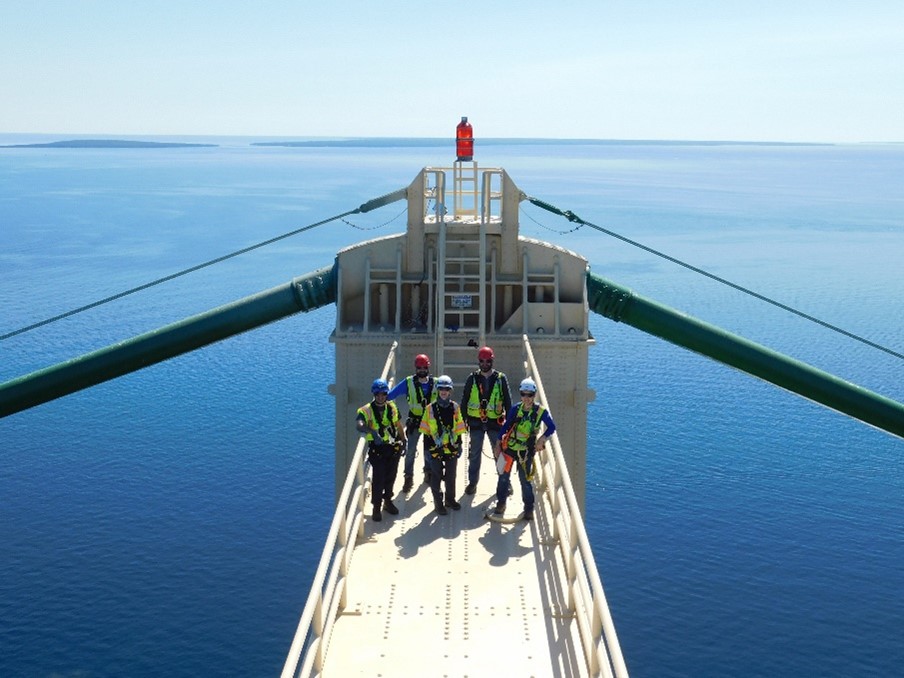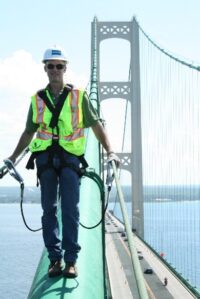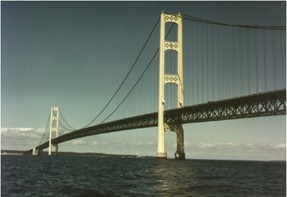
Back row left to right: Faris Karahasanovic, Sean Bolduc.
To celebrate the launch of our employer brand, we’re highlighting a few of the stories that epitomize what our employees love about working at Parsons (expressed in our recently released employee value proposition) as well as what they’re doing to imagine next.
Our employee value proposition begins with the following lines:
Imagine working someplace where you’re surrounded by intelligent, diverse people sharing a common quest. Imagine working someplace where those people take immense pride in the quality of their work and champion that same quality in the work of others.

An intelligent person who takes pride in the quality of his work and champions quality in the work of others? That sounds an awful lot like Tom Spoth.
Tom is a VP working out of our New York office, our bridge practice lead, a founding board member of the Parsons Fellows, and he’s responsible for leading our efforts as quality inspector of the Mackinac Bridge.
To get an idea of what he’s dealing with, the Mackinac Bridge is a 5-mile-long structure that connects the upper and lower peninsulas of Michigan over the Straits of Mackinac. It was originally designed and built by Steinman, completed in 1957. Steinman was subsequently acquired by Parsons, in 1989, and became a big part of our New York office center of excellence, and we’ve been involved with the Mackinac Bridge ever since.
Tom himself, who came to us through the Steinman acquisition, has spent time on the Mackinac Bridge every year since 1985, so he’s intimately familiar with the structure, as well as the commitment to quality necessary to maintain such a crossing in good working order for such a long time. “Quality as part of the job and quality as part of our culture go hand-in-hand,” Tom says. “Getting it right and having procedures is necessary, but it’s also necessary to take personal ownership of quality in whatever you do.”
When it comes to the Mackinac Bridge, there are certainly procedures to be followed, but there’s also something very personal about hands-on inspections. According to Tom, “These bridges are machines. People don’t realize how much they move.” He describes hearing the creaking and screeching of various components and feeling the bridge move, perceiving how the bridge is behaving, mechanically, compared to how it should or how it did in years prior. “Your first time out there, you might never realize it,” he says.

So each year, we send people out to the Mackinac Bridge for a few weeks for an end-to-end inspection, including the bearings, the cables, down deep into the anchorages for the cables, the approach span trusses, and everything else, and we provide guidance on maintenance and any major construction activities. For example, in recent years, Parsons performed a very in-depth bridge deck study to determine how long the deck could be made to last. This involved service-life modeling, analysis of alternatives, wind tunnel testing, and the development of a potential program to replace the bridge deck over a period of 20 years. While not every component lasts forever, Tom says that the bridge itself just might, if taken care of properly.
That kind of high standard is something everyone can aspire to, but to achieve it takes a certain level of experience. That’s why Tom does what he can to share his years of experience with younger professionals just starting out. “The code books are very prescriptive,” he says, “but you still have to have experience with the living mechanisms of these bridges to really understand them.” So Tom keeps his door open and is always willing to talk.
In addition to an open door, Tom keeps an open mind.
There’s some cookie-cutter stuff out there, I suppose, but I like the complicated stuff that requires creativity—the stuff that makes people ask things like, ‘How are we going to do this and still allow traffic on the bridge and not even let commuters know there’s anything going on?'”
It’s that kind of high-level problem solving—and the collaboration required to accomplish it—that keeps Tom motivated.
Whether maintaining an iconic crossing like the Mackinac Bridge, designing a new structure, or tinkering with a woodworking project at home, Tom believes the ability to think many steps ahead, to imagine what’s next, is vitally important to the success of the end result. “It’s about vision and being able to put all the pieces and parts together to make them become something that wasn’t there before.” What we can be sure of is that if Tom’s involved, whatever thing that is will only strengthen Parsons’ reputation for quality.